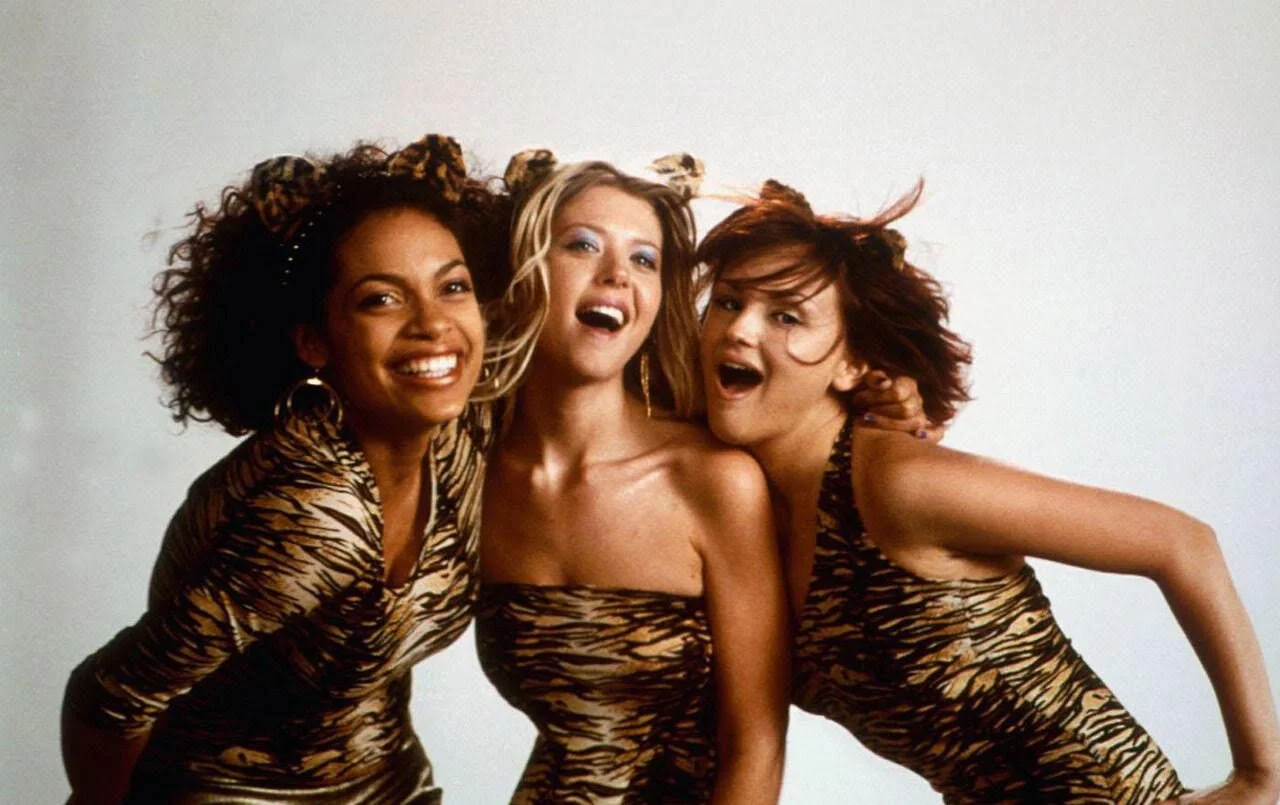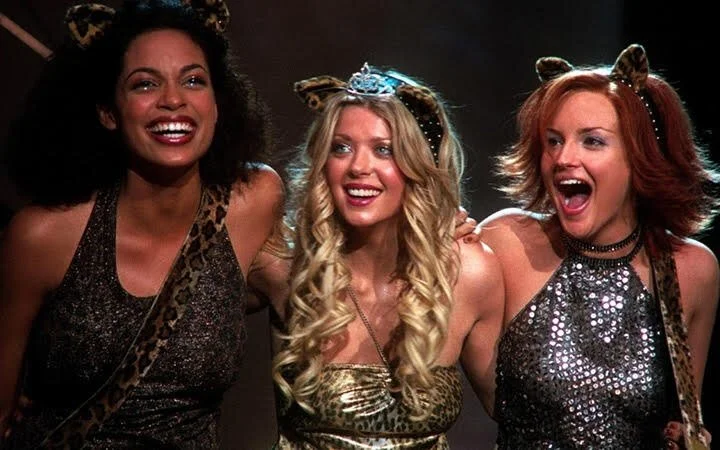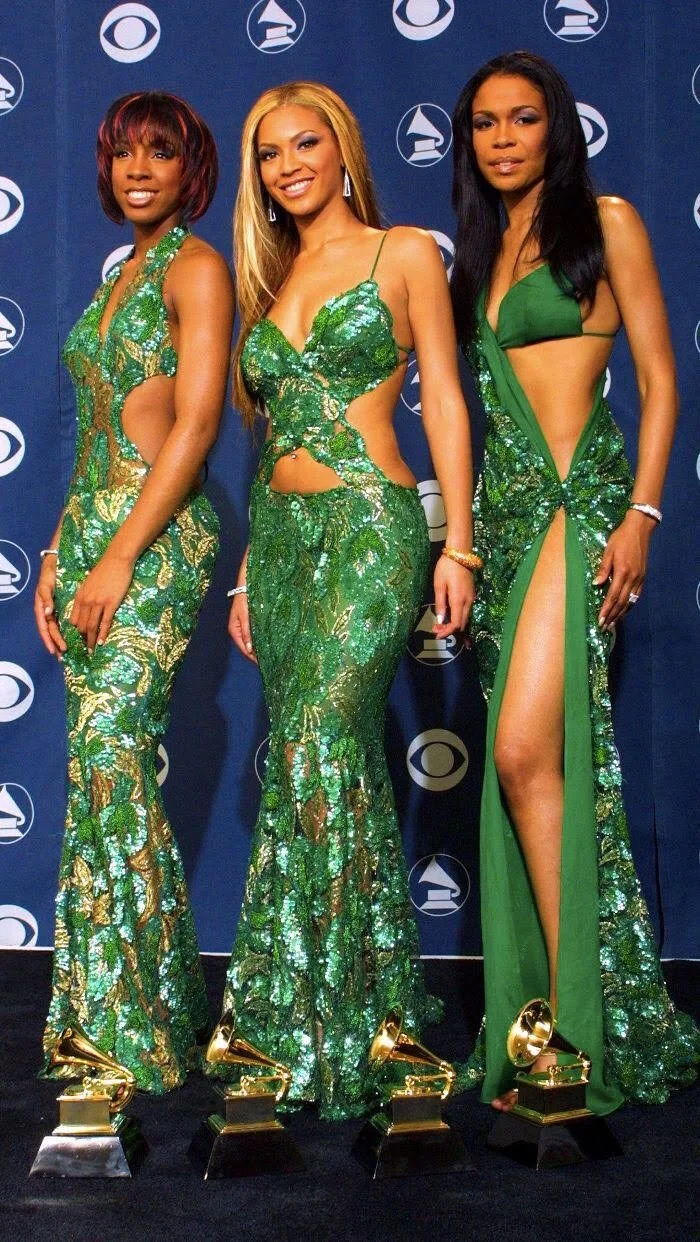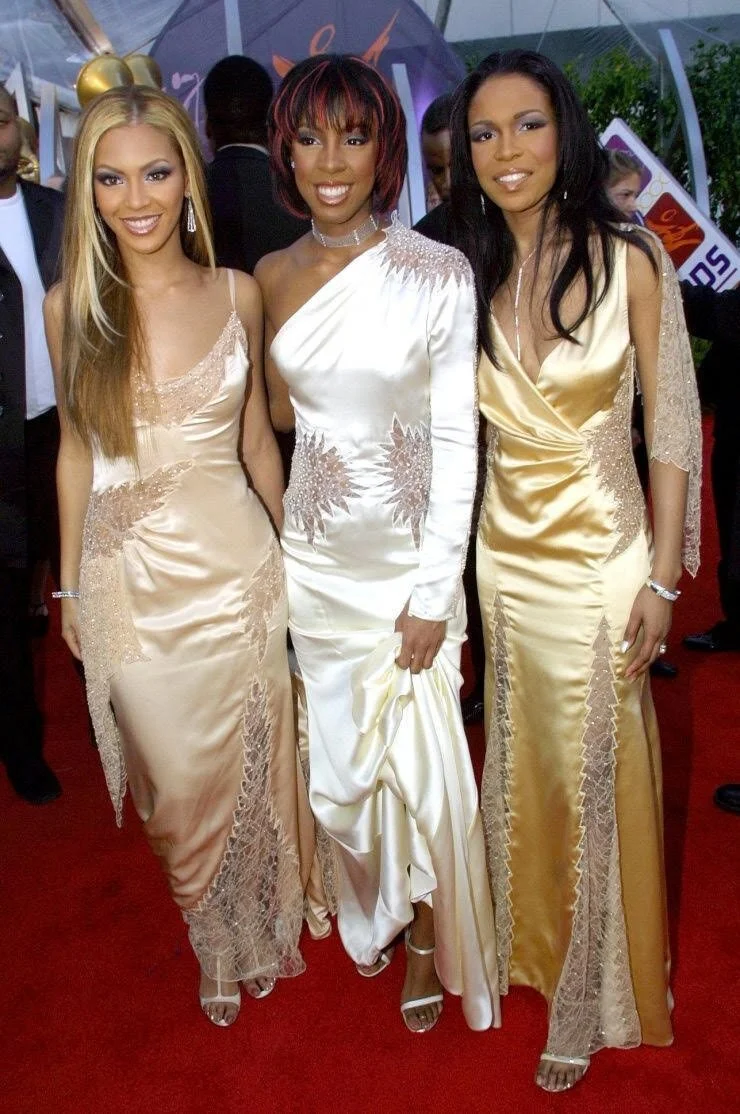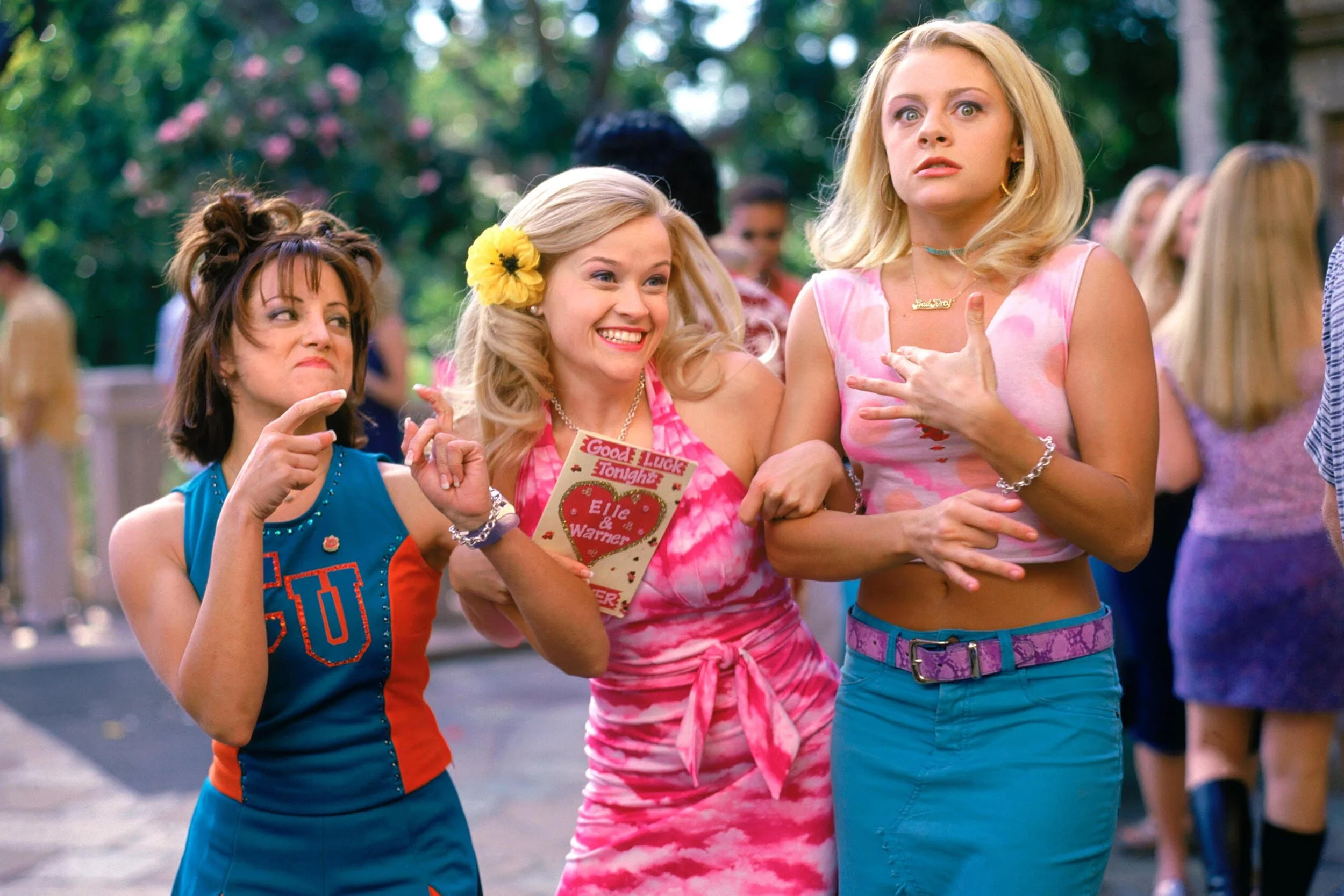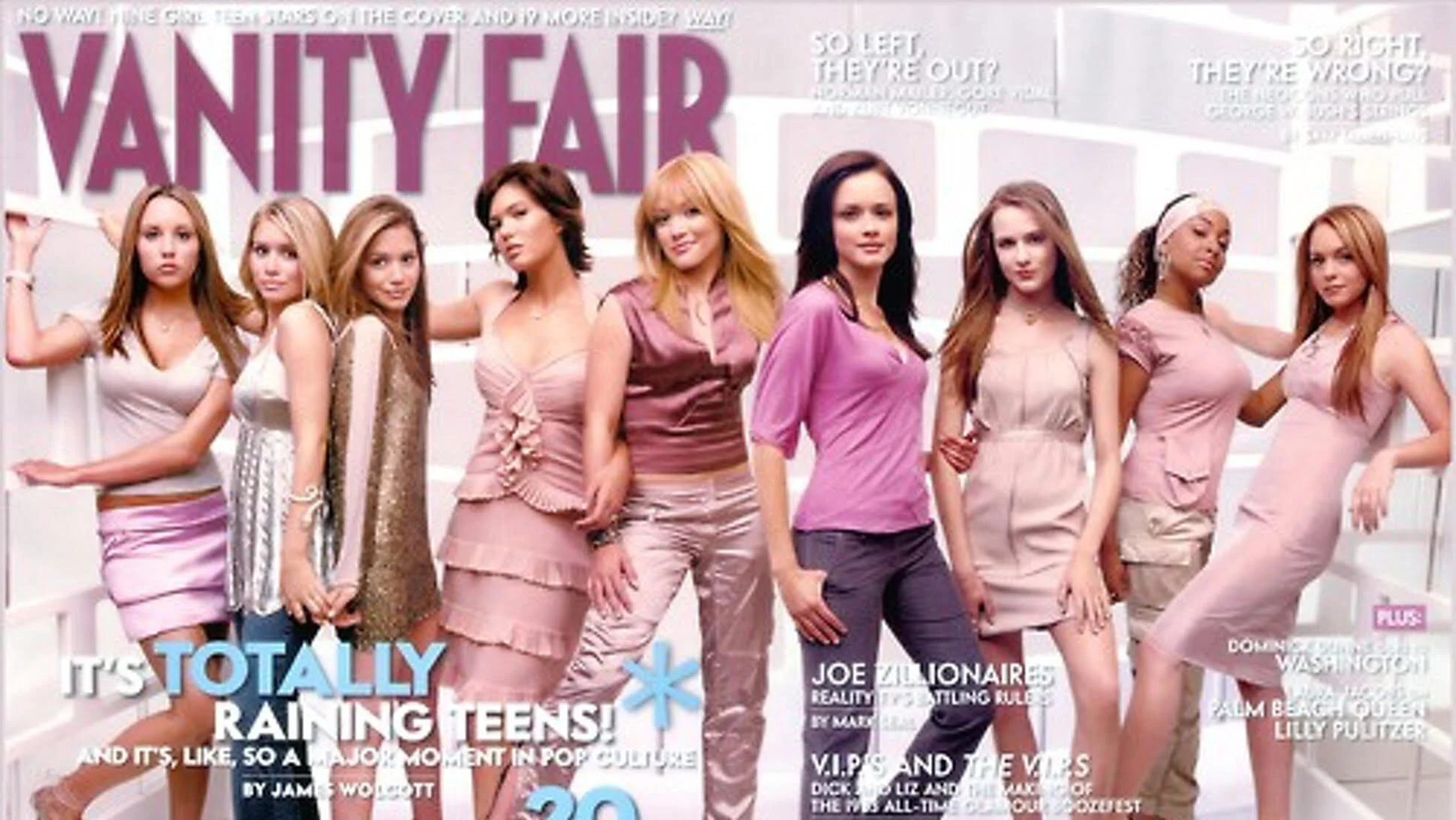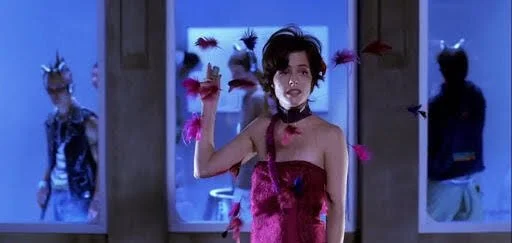Bonus: The Fashion Of Josie And The Pussycats
From tonal dressing to an intense shimmer lip, the underrated impact of Josie And The Pussycats visual storytelling is still felt writes Maria Lewis.
All films act as time capsules in their way, yet when it comes to turn of the millennium snapshots there are few crisper than Josie And The Pussycats. The film – shot in 2000 and released in 2001 - features so many of the iconic trends of the period as we moved from the nineties and into the naughties. The great Y2K fear had come and gone and that’s crucial to the fashion journey of the film, because it influences a lot of what we see on screen: namely metallics. Before Josie, Melody, and Valerie get brought into the world of rock pop superstars, they’re considered untrendy in their Archie Comics town of Riverdale. The bulk of the population is being brainwashed to adhere to trends, which is represented visually by everyone wearing one colour, pink or blue, before collectively mass shifting to another, like orange. As Josie quips at one point: “hey, did you guys all coordinate before you left the house or are you all wearing the same thing by accident?”
The sheep, the folks who ostracise the girls of the band, they’re supposed to represent ‘the norm’. It’s no coincidence they dress like characters in a big hit from the same studio – Universal – which dropped just a few years earlier: American Pie. The teen bro comedy came out in 1999, with Leesa Evans serving as the costume designer. In fact, she was the go-to Universal girl and worked on several other teen centric properties, like Whatever It Takes. All of the characters in those films represented ‘the norm’ and it’s not an accident majority of Riverdale look like they could fit into a version of American Pie.
To demonstrate that Josie and the Pussycats are individuals, they look different from everyone else in the town. Their costumes lean harder into the post-grunge era, like stylish burn outs in a way, so that’s a darker palette: blacks, warm browns, maroons, greys. They have chunky foils in their hair in Josie’s case and twists verging on lite-dreadlocks in Melody’s, with Valerie’s natural hair bold and beautiful as it’s unleashed in full force. It’s in sharp juxtaposition to the dead straight, glossy locks of their tormentors. They have chains hanging from their pockets, everything is adorned with studs, there are chokers, tassels, random placement of fishnet, leather, velvet, sheer tops with black bras visible underneath, and boots: those with the thick heel and chunky sole in the era of Dr. Martens. This is their uniform before they’re “discovered” and it’s a capital L LOOK not dissimilar to the costumes worn in another movie that came out in 2001, six months after Josie: the very first Fast And Furious.
When the band gets offered their dream record deal by Alan Cumming’s Wyatt, there’s a makeover montage (which is a beloved movie trope for a reason: it’s fun and it works). When they emerge, they’re a shiny version of all the hottest trends at that specific moment. For hair, that means intense layers a la Veronica Mars season one, butterfly clips, tiny tiaras that serve no purpose, hair glitter, small piggy tails, and any kind of bejewelled accessory that can nestle amongst your follicles. Makeup is an extension of the post-Y2K metallics: shimmer, baby. A shimmer lip! Shimmer highlighter on your cheekbones! A layer of shimmer on your eyebrow! And thin eyebrows while we’re at: your happiness has to be plucked away hair-by-hair. Thick, silver under-eyeliner is a must, along with diamontes placed strategically at the edge of your eye, glitter eye shadow, and a glossy or shimmer lip was crucial. A bold pigment was not the sartorial statement circa 2000/2001 that it is now.
As for the clothing, it was spaghetti straps, boob tubes (so many boob tubes), asymmetrical everything – dresses, skirts, tops – halters with soft and hard straps, bandanna tops, low rise pants with a flare … everything had to flare. The biggest trend for the girls of Josie and the Pussycats specifically and a big 2000s trend was tonal dressing. Now you might not know what that means off the top of your head, but you will definitely know what it means when you see it: one of the key drivers of this trend after all was Destiny’s Child. Say My Name was a big hit in the year 2000 and the accompanying video was tonal dressing manifested. Each of the band members dressed in colours that matched a set in that same shade, before the physical sets moved and they were displaced into another palette. Outside of the video, Destiny’s Child were famous for tonal dressing on basically every red carpet they walked largely thanks to the styling of Beyoncé’s mother, Tina Knowles, especially when the group cemented themselves as a trio with Kelly and Michelle.
This quite unusual for the period, especially when you look at the most successful girl group in the world at that time: the Spice Girls. From their names – Baby, Scary, Sporty, Posh, Ginger – to the way they were styled, the intention was to set each girl apart from the other. Whereas Destiny’s Child’s tonal dressing – whether that was all jungle print or all purple, for instance – was intended to show that yes, okay, they were individuals but they were also collectively united as a group – a girl group! When the girls are the girls of Josie and the Pussycats and backed by a big, evil conglomerate in the film, they’re tonal dressing. They’re either all in varying leopard print, all in versions of a pastel metallics, all in garments in the pink and purple palette, all in shimmer like the Pretend To Be Nice video (which also has them all washing a car in a polished version of their earlier grunge aesthetic)
It’s something Leesa Evans and the Josie And The Pussycats movie as a whole executes damn near flawlessly …. which is a shame, because when the movie opened in April of 2001 it flops so not as many people see this flawless execution as they should have (and as Universal hoped). Yet the fashion from the film and the messaging communicated through it goes on to inspire some other key properties, like Legally Blonde that drops in October of 2001 and looks like the stylistic ying to Josie And The Pussycats yang. Then Evans - with her honed, tonal dressing skills and having just worked on a comic and cartoon-to-live action-property - jumps on board Scooby-Doo in 2002 and its sequel in 2004 as the costume designer. The visual through-line there is really clear, especially through what Velma and Daphne wear. It’s clearer still when Vanity Fair release the cover for their annual Hollywood issue, focusing largely on teen stars that were dominating at the time. Hilary Duff, Mandy Moore, the Olsen twins, Amanda Bynes, Alexis Bledel, Evan Rachel Wood, Raven Symone and – naturally – Lindsay Lohan are all fitted in metallic pastels in the pink to purple palette. If you’d said this cover was shot on the set of Josie And The Pussycats, it would be extremely believable.
It’s also important to touch on Parker Posey’s character of Fiona for a moment, who for all. intents and purposes is a cartoon Bond villain. When Josie, Melody and Valerie represent the trends of the era, they represent the accessible trends: they’re all things you could easily purchase at your local Forever 21, Supré, H & M or via the tie-in Target line of Josie outfits. Fiona is inaccessible, so she represents a hyper-realised version of all the couture trends of the period and her costuming is designed to poke fun at that. Even her open plan office of henchmen and women scheming alongside her make fun at that. “Feathered tank tops, matching pants, kind of Buffy meets Chicken Run,” says one. “Feathers are the new rhinestones!” exclaims another. Fiona is an OTT parody of runway trends from that minute, making her one of the funnest characters to cosplay from the movie and one of Parker Posey’s most enduring oddballs visually. Take Doja Cat’s ensemble at the 2019 BET Awards, which is less of a wink to the character and more full on shout out. And yes, her name is Doja Cat so there’s plenty of reason for cat imagery (such as the ‘meow meow’ glasses). Yet the cat ears she wears are almost identical to the cat ear headbands manufactured in the final act of Josie And The Pussycats. She wears a feather, wire contraption exactly like Fiona’s and a gown that matches, boldly taking the aesthetic of a nearly 20-year old film into the present.
This article is a written version of the Josie and the Podcats bonus episode Fashion. Josie and the Podcats is a limited podcast series hosted by best-selling author, screenwriter and journalist Maria Lewis, and produced by Blake Howard of One Heat Minute. New episodes release every Sunday, with bonus episodes during the week.
